I am learning to understand advantages & disadvantages
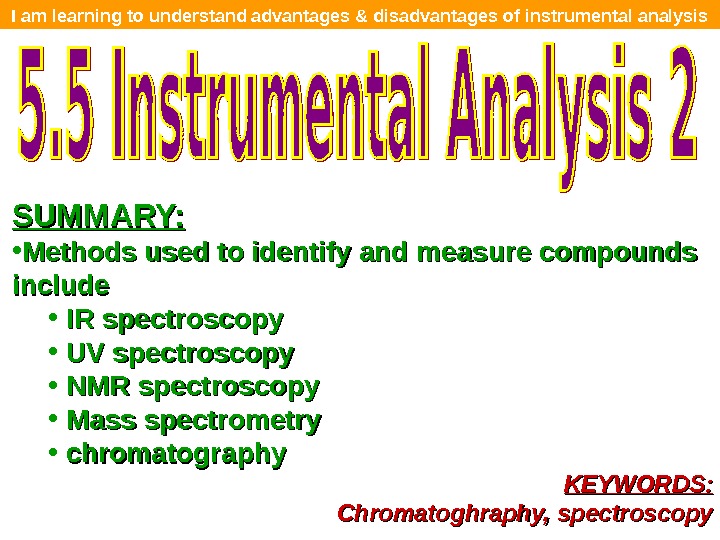
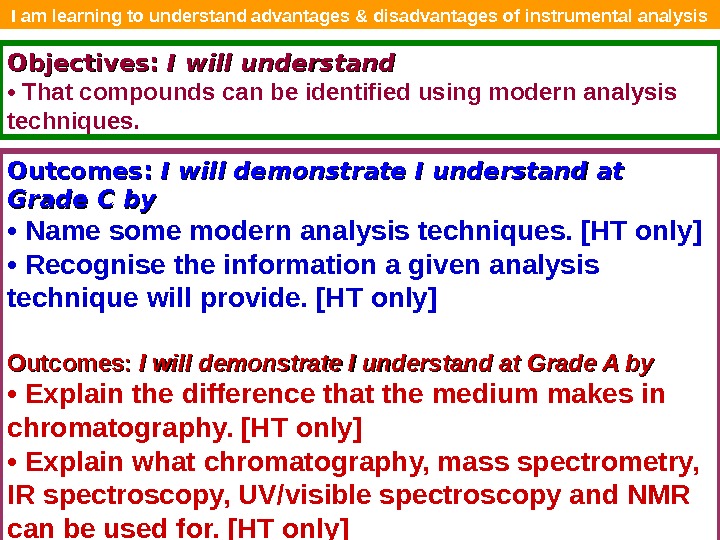
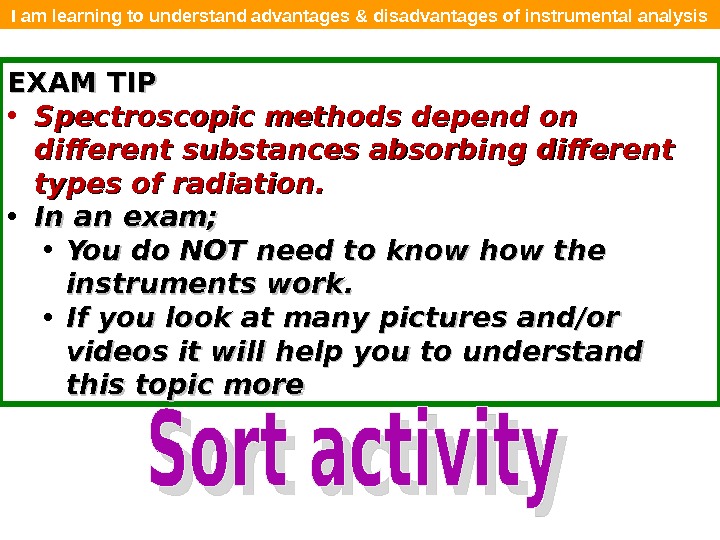



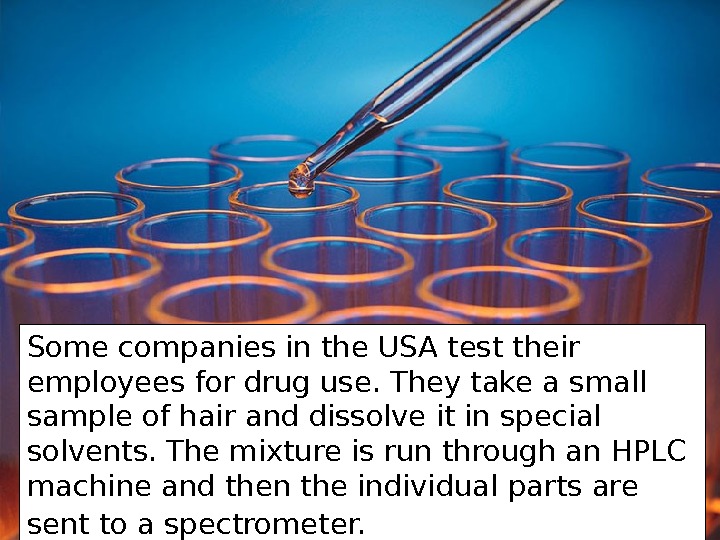

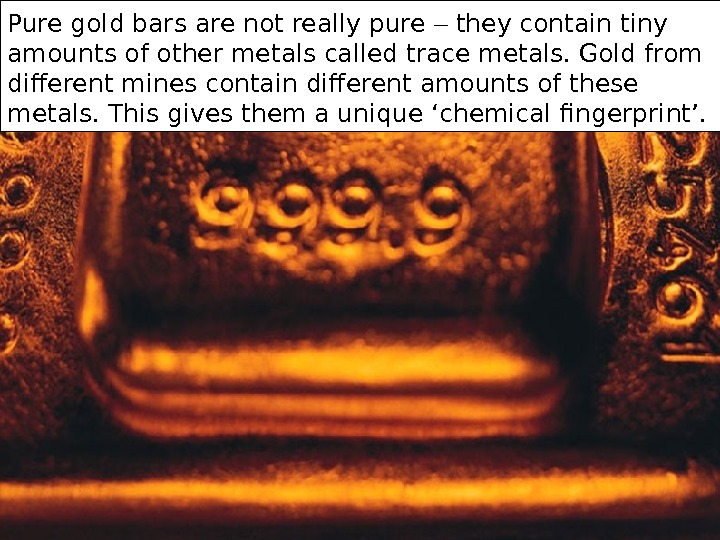

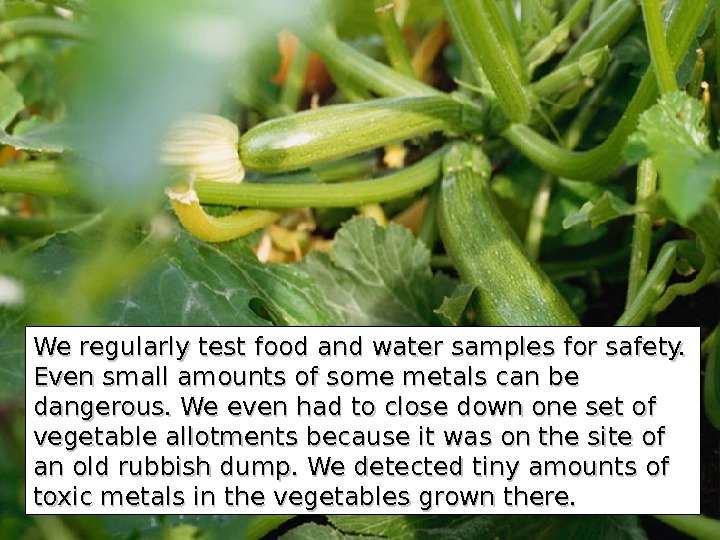


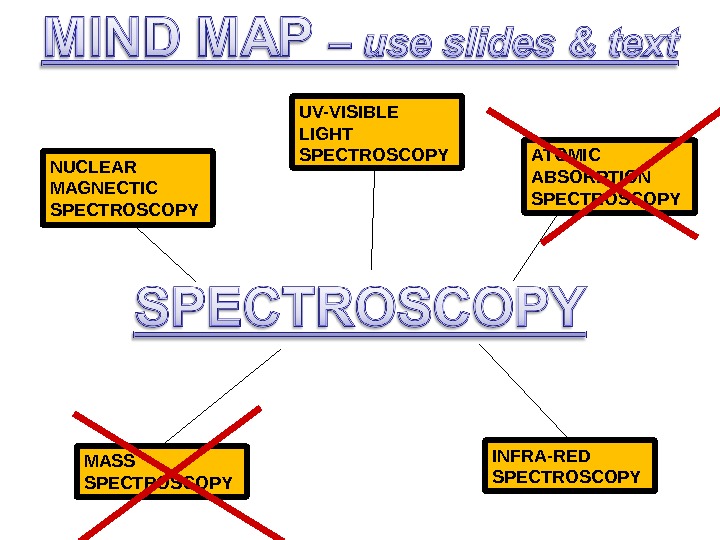
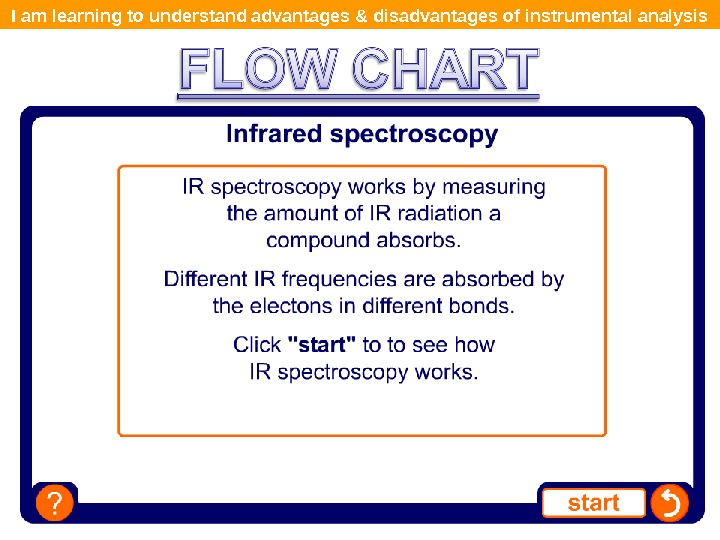
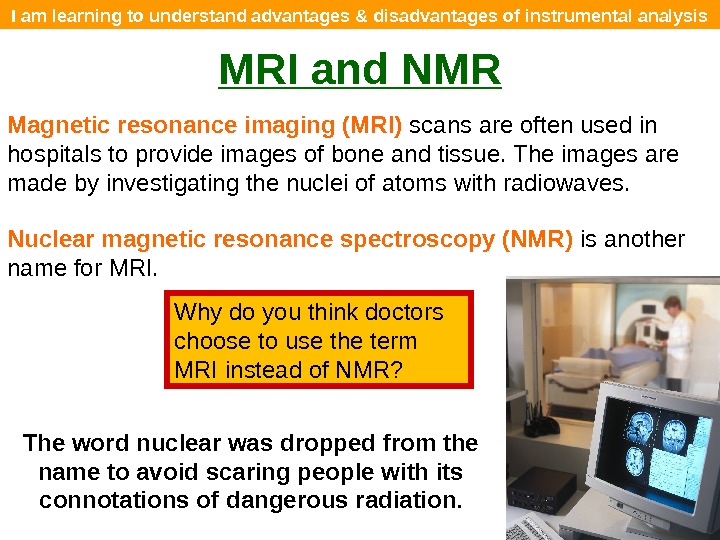

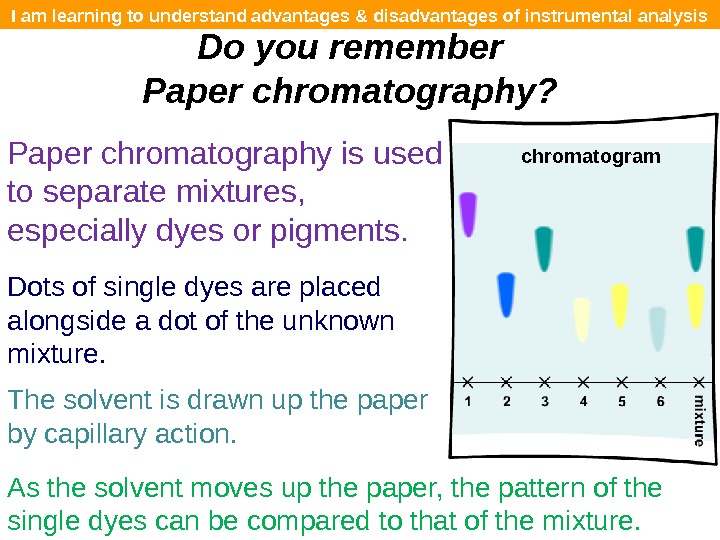

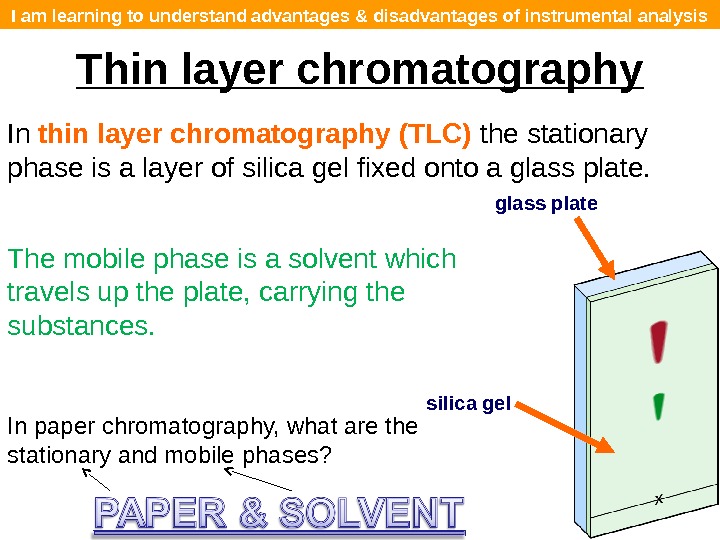

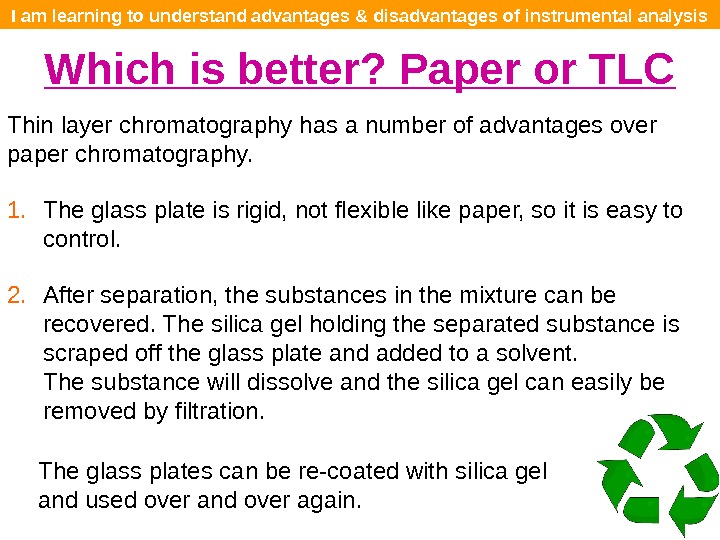
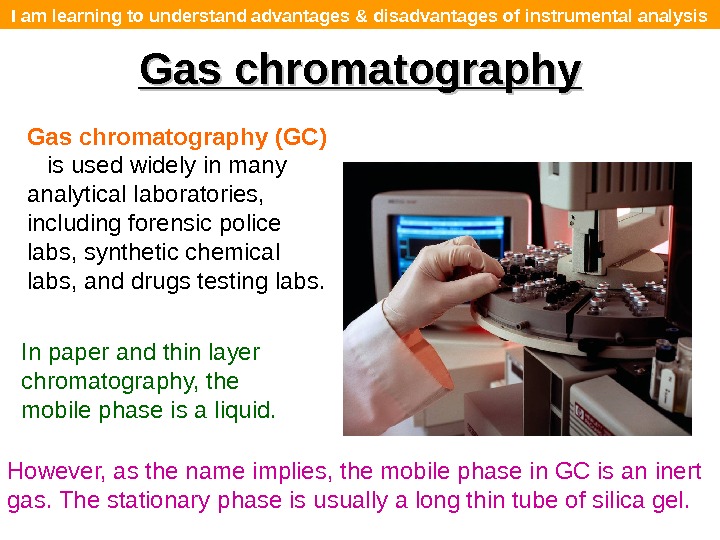
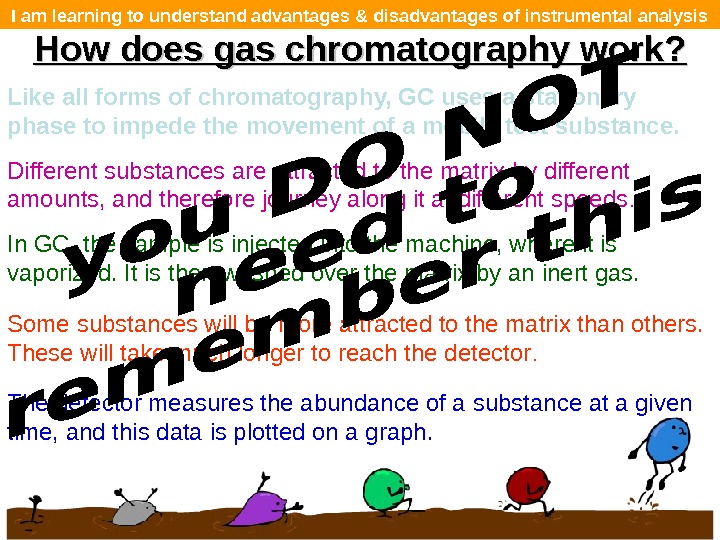


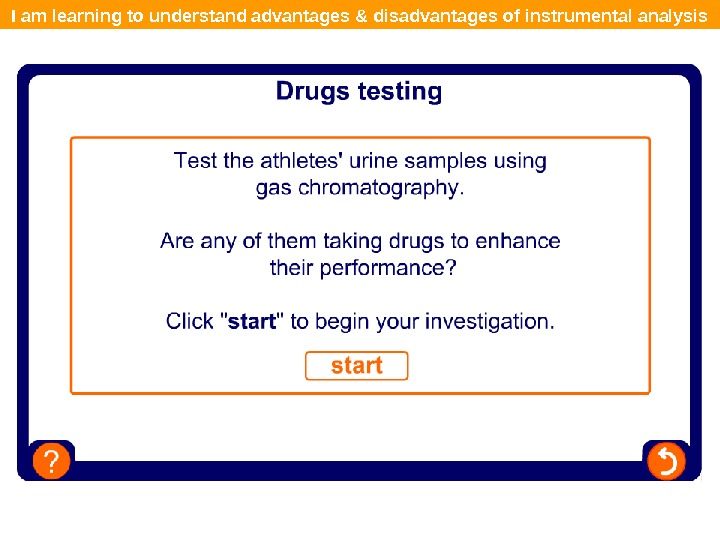

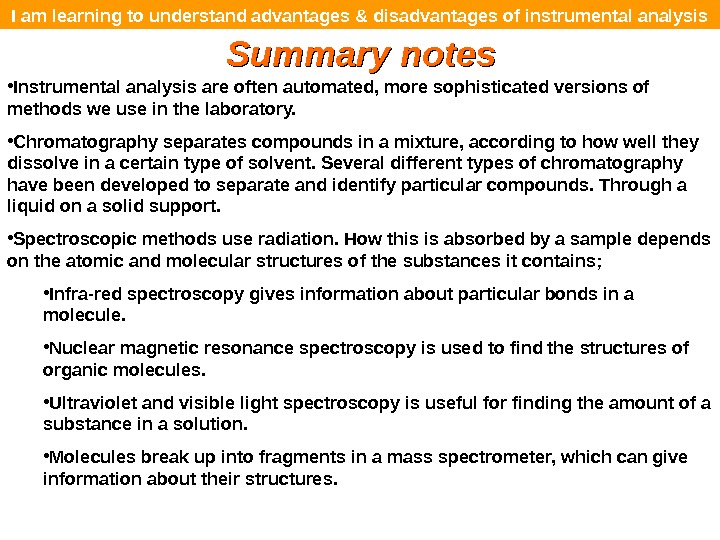
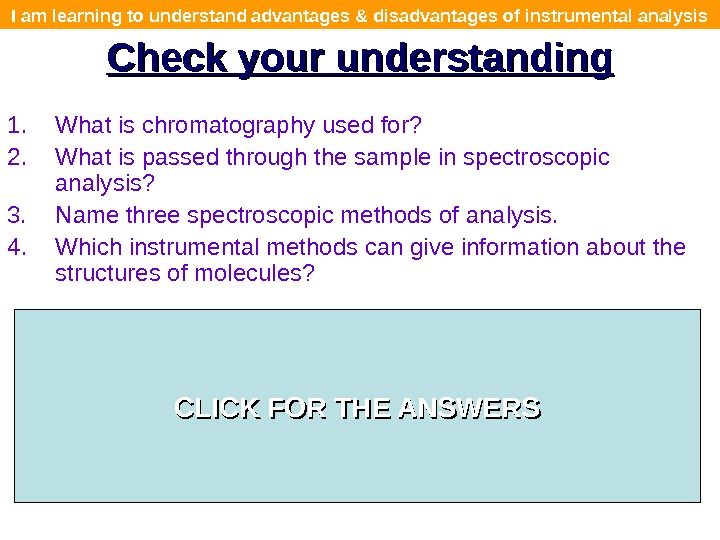
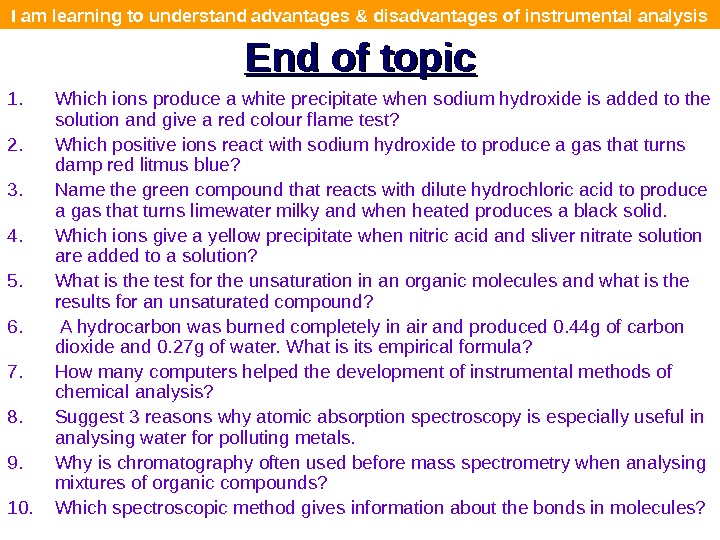






c3_5.5_instrumental_analysis_2.ppt
- Размер: 2.8 Mегабайта
- Количество слайдов: 37
Описание презентации I am learning to understand advantages & disadvantages по слайдам
 I am learning to understand advantages & disadvantages of instrumental analysis SUMMARY: • Methods used to identify and measure compounds include • IR spectroscopy • UV spectroscopy • NMR spectroscopy • Mass spectrometry • chromatography KEYWORDS: Chromatoghraphy, spectroscopy
I am learning to understand advantages & disadvantages of instrumental analysis SUMMARY: • Methods used to identify and measure compounds include • IR spectroscopy • UV spectroscopy • NMR spectroscopy • Mass spectrometry • chromatography KEYWORDS: Chromatoghraphy, spectroscopy
 I am learning to understand advantages & disadvantages of instrumental analysis Outcomes: I will demonstrate I understand at Grade C by • Name some modern analysis techniques. [HT only] • Recognise the information a given analysis technique will provide. [HT only] Outcomes: I will demonstrate I understand at Grade A by • Explain the difference that the medium makes in chromatography. [HT only] • Explain what chromatography, mass spectrometry, IR spectroscopy, UV/visible spectroscopy and NMR can be used for. [HT only] Objectives: I will understand • That compounds can be identified using modern analysis techniques.
I am learning to understand advantages & disadvantages of instrumental analysis Outcomes: I will demonstrate I understand at Grade C by • Name some modern analysis techniques. [HT only] • Recognise the information a given analysis technique will provide. [HT only] Outcomes: I will demonstrate I understand at Grade A by • Explain the difference that the medium makes in chromatography. [HT only] • Explain what chromatography, mass spectrometry, IR spectroscopy, UV/visible spectroscopy and NMR can be used for. [HT only] Objectives: I will understand • That compounds can be identified using modern analysis techniques.
 I am learning to understand advantages & disadvantages of instrumental analysis EXAM TIP • Spectroscopic methods depend on different substances absorbing different types of radiation. • In an exam; • You do NOT need to know how the instruments work. • If you look at many pictures and/or videos it will help you to understand this topic more
I am learning to understand advantages & disadvantages of instrumental analysis EXAM TIP • Spectroscopic methods depend on different substances absorbing different types of radiation. • In an exam; • You do NOT need to know how the instruments work. • If you look at many pictures and/or videos it will help you to understand this topic more
 I am learning to understand advantages & disadvantages of instrumental analysis Hello, my name is Dr Jackie Snow. I work for Analytical Chemists Ltd, a company that identifies unknown chemicals in mixtures. We have carried out work for governments, research scientists, food and drink companies and even for the United Nations.
I am learning to understand advantages & disadvantages of instrumental analysis Hello, my name is Dr Jackie Snow. I work for Analytical Chemists Ltd, a company that identifies unknown chemicals in mixtures. We have carried out work for governments, research scientists, food and drink companies and even for the United Nations.
 I am learning to understand advantages & disadvantages of instrumental analysis Whenever we are given a new mixture to analyse, the first job is to sort it out. We use a variety of techniques but the most common ones are to do with chromatography. The picture shows our high performance liquid chromatogram (HPLC) and we also use a gas-liquid chromatogram (GLC). In our Bristol offices, we have some ion-exchange chromatography machines and a gel permeation unit. Varian Inc
I am learning to understand advantages & disadvantages of instrumental analysis Whenever we are given a new mixture to analyse, the first job is to sort it out. We use a variety of techniques but the most common ones are to do with chromatography. The picture shows our high performance liquid chromatogram (HPLC) and we also use a gas-liquid chromatogram (GLC). In our Bristol offices, we have some ion-exchange chromatography machines and a gel permeation unit. Varian Inc
 I am learning to understand advantages & disadvantages of instrumental analysis We do some drug testing work for the Olympic Committee. Our most famous case was Ben Johnson in 1988. He won the Gold Medal for the 100 m sprint at the Seoul Olympics but lost it a few days later when we showed his urine contained samples of a banned substance.
I am learning to understand advantages & disadvantages of instrumental analysis We do some drug testing work for the Olympic Committee. Our most famous case was Ben Johnson in 1988. He won the Gold Medal for the 100 m sprint at the Seoul Olympics but lost it a few days later when we showed his urine contained samples of a banned substance.
 I am learning to understand advantages & disadvantages of instrumental analysis Some companies in the USA test their employees for drug use. They take a small sample of hair and dissolve it in special solvents. The mixture is run through an HPLC machine and then the individual parts are sent to a spectrometer.
I am learning to understand advantages & disadvantages of instrumental analysis Some companies in the USA test their employees for drug use. They take a small sample of hair and dissolve it in special solvents. The mixture is run through an HPLC machine and then the individual parts are sent to a spectrometer.
 I am learning to understand advantages & disadvantages of instrumental analysis We use three different spectrometers – they can use ultraviolet and infrared radiation to identify compounds. We also have a mass spectrometer (MS) that can measure the molecular mass of individual compounds and identify them in that way.
I am learning to understand advantages & disadvantages of instrumental analysis We use three different spectrometers – they can use ultraviolet and infrared radiation to identify compounds. We also have a mass spectrometer (MS) that can measure the molecular mass of individual compounds and identify them in that way.
 I am learning to understand advantages & disadvantages of instrumental analysis Pure gold bars are not really pure – they contain tiny amounts of other metals called trace metals. Gold from different mines contain different amounts of these metals. This gives them a unique ‘chemical fingerprint’.
I am learning to understand advantages & disadvantages of instrumental analysis Pure gold bars are not really pure – they contain tiny amounts of other metals called trace metals. Gold from different mines contain different amounts of these metals. This gives them a unique ‘chemical fingerprint’.
 I am learning to understand advantages & disadvantages of instrumental analysis During WWII the Nazis stole gold from many countries. They hoped that when it was melted down no-one would be able to trace it. Wrong! Our MS can detect the trace elements and work out where the gold came from. We have been able to return gold to its rightful owners using this technique. ILNV 1.
I am learning to understand advantages & disadvantages of instrumental analysis During WWII the Nazis stole gold from many countries. They hoped that when it was melted down no-one would be able to trace it. Wrong! Our MS can detect the trace elements and work out where the gold came from. We have been able to return gold to its rightful owners using this technique. ILNV 1.
 I am learning to understand advantages & disadvantages of instrumental analysis We regularly test food and water samples for safety. Even small amounts of some metals can be dangerous. We even had to close down one set of vegetable allotments because it was on the site of an old rubbish dump. We detected tiny amounts of toxic metals in the vegetables grown there.
I am learning to understand advantages & disadvantages of instrumental analysis We regularly test food and water samples for safety. Even small amounts of some metals can be dangerous. We even had to close down one set of vegetable allotments because it was on the site of an old rubbish dump. We detected tiny amounts of toxic metals in the vegetables grown there.
 I am learning to understand advantages & disadvantages of instrumental analysis We also test organic vegetables to see if any pesticides are present. If they are, the vegetables are not organic – so we can tell if your greengrocer is trying to cheat you by charging extra for ‘organic’ leeks!
I am learning to understand advantages & disadvantages of instrumental analysis We also test organic vegetables to see if any pesticides are present. If they are, the vegetables are not organic – so we can tell if your greengrocer is trying to cheat you by charging extra for ‘organic’ leeks!
 I am learning to understand advantages & disadvantages of instrumental analysis Flash revision cards • You each have 11 pages in which to summarise your understanding of each of the analysis techniques. Include; – How it is used – What is separated – What is the separation based upon
I am learning to understand advantages & disadvantages of instrumental analysis Flash revision cards • You each have 11 pages in which to summarise your understanding of each of the analysis techniques. Include; – How it is used – What is separated – What is the separation based upon
 ATOMIC ABSORPTION SPECTROSCOPYNUCLEAR MAGNECTIC SPECTROSCOPY INFRA-RED SPECTROSCOPYMASS SPECTROSCOPY UV-VISIBLE LIGHT SPECTROSCOPY
ATOMIC ABSORPTION SPECTROSCOPYNUCLEAR MAGNECTIC SPECTROSCOPY INFRA-RED SPECTROSCOPYMASS SPECTROSCOPY UV-VISIBLE LIGHT SPECTROSCOPY
 I am learning to understand advantages & disadvantages of instrumental analysis
I am learning to understand advantages & disadvantages of instrumental analysis
 I am learning to understand advantages & disadvantages of instrumental analysis MRI and NMR Magnetic resonance imaging (MRI) scans are often used in hospitals to provide images of bone and tissue. The images are made by investigating the nuclei of atoms with radiowaves. Nuclear magnetic resonance spectroscopy (NMR) is another name for MRI. Why do you think doctors choose to use the term MRI instead of NMR? The word nuclear was dropped from the name to avoid scaring people with its connotations of dangerous radiation.
I am learning to understand advantages & disadvantages of instrumental analysis MRI and NMR Magnetic resonance imaging (MRI) scans are often used in hospitals to provide images of bone and tissue. The images are made by investigating the nuclei of atoms with radiowaves. Nuclear magnetic resonance spectroscopy (NMR) is another name for MRI. Why do you think doctors choose to use the term MRI instead of NMR? The word nuclear was dropped from the name to avoid scaring people with its connotations of dangerous radiation.
 THIN LAYER CHROMATOGRAPHY PAPER CHROMATOGRAPHY GAS-LIQUID CHROMATOGRAPHY HIGH PERFORMANCE LIQUID CHROMATOGRAPHYGEL PERMEATION CHROMATOGRAPHY ION-EXCHANGE CHROMATOGRAPHY
THIN LAYER CHROMATOGRAPHY PAPER CHROMATOGRAPHY GAS-LIQUID CHROMATOGRAPHY HIGH PERFORMANCE LIQUID CHROMATOGRAPHYGEL PERMEATION CHROMATOGRAPHY ION-EXCHANGE CHROMATOGRAPHY
 I am learning to understand advantages & disadvantages of instrumental analysis Do you remember Paper chromatography? Paper chromatography is used to separate mixtures, especially dyes or pigments. As the solvent moves up the paper, the pattern of the single dyes can be compared to that of the mixture. Dots of single dyes are placed alongside a dot of the unknown mixture. chromatogram The solvent is drawn up the paper by capillary action.
I am learning to understand advantages & disadvantages of instrumental analysis Do you remember Paper chromatography? Paper chromatography is used to separate mixtures, especially dyes or pigments. As the solvent moves up the paper, the pattern of the single dyes can be compared to that of the mixture. Dots of single dyes are placed alongside a dot of the unknown mixture. chromatogram The solvent is drawn up the paper by capillary action.
 I am learning to understand advantages & disadvantages of instrumental analysis
I am learning to understand advantages & disadvantages of instrumental analysis
 I am learning to understand advantages & disadvantages of instrumental analysis Thin layer chromatography In thin layer chromatography (TLC) the stationary phase is a layer of silica gel fixed onto a glass plate. The mobile phase is a solvent which travels up the plate, carrying the substances. In paper chromatography, what are the stationary and mobile phases? glass plate silica gel
I am learning to understand advantages & disadvantages of instrumental analysis Thin layer chromatography In thin layer chromatography (TLC) the stationary phase is a layer of silica gel fixed onto a glass plate. The mobile phase is a solvent which travels up the plate, carrying the substances. In paper chromatography, what are the stationary and mobile phases? glass plate silica gel
 I am learning to understand advantages & disadvantages of instrumental analysis How does TLC work? Capillary action still draws the solvent up the matrix; however while the molecules in paper chromatography are separated based on mass, in TLC, separation often depends upon solubility or charge , due to the interaction of solute and matrix. A dry sample is placed in the silica gel matrix. As the solvent front moves up the gel, it dissolves the sample and carries it up the matrix with it. Some of the particles in the sample stick more strongly to the silica gel than others, so they lag behind the solvent. Eventually the different substances in the sample separate out , with similar molecules travelling a similar distance.
I am learning to understand advantages & disadvantages of instrumental analysis How does TLC work? Capillary action still draws the solvent up the matrix; however while the molecules in paper chromatography are separated based on mass, in TLC, separation often depends upon solubility or charge , due to the interaction of solute and matrix. A dry sample is placed in the silica gel matrix. As the solvent front moves up the gel, it dissolves the sample and carries it up the matrix with it. Some of the particles in the sample stick more strongly to the silica gel than others, so they lag behind the solvent. Eventually the different substances in the sample separate out , with similar molecules travelling a similar distance.
 I am learning to understand advantages & disadvantages of instrumental analysis Which is better? Paper or TLC Thin layer chromatography has a number of advantages over paper chromatography. 1. The glass plate is rigid, not flexible like paper, so it is easy to control. 2. After separation, the substances in the mixture can be recovered. The silica gel holding the separated substance is scraped off the glass plate and added to a solvent. The substance will dissolve and the silica gel can easily be removed by filtration. The glass plates can be re-coated with silica gel and used over and over again.
I am learning to understand advantages & disadvantages of instrumental analysis Which is better? Paper or TLC Thin layer chromatography has a number of advantages over paper chromatography. 1. The glass plate is rigid, not flexible like paper, so it is easy to control. 2. After separation, the substances in the mixture can be recovered. The silica gel holding the separated substance is scraped off the glass plate and added to a solvent. The substance will dissolve and the silica gel can easily be removed by filtration. The glass plates can be re-coated with silica gel and used over and over again.
 I am learning to understand advantages & disadvantages of instrumental analysis Gas chromatography (GC) is used widely in many analytical laboratories, including forensic police labs, synthetic chemical labs, and drugs testing labs. In paper and thin layer chromatography, the mobile phase is a liquid. However, as the name implies, the mobile phase in GC is an inert gas. The stationary phase is usually a long thin tube of silica gel.
I am learning to understand advantages & disadvantages of instrumental analysis Gas chromatography (GC) is used widely in many analytical laboratories, including forensic police labs, synthetic chemical labs, and drugs testing labs. In paper and thin layer chromatography, the mobile phase is a liquid. However, as the name implies, the mobile phase in GC is an inert gas. The stationary phase is usually a long thin tube of silica gel.
 I am learning to understand advantages & disadvantages of instrumental analysis How does gas chromatography work? Like all forms of chromatography, GC uses a stationary phase to impede the movement of a mobile test substance. Different substances are attracted to the matrix by different amounts, and therefore journey along it at different speeds. In GC, the sample is injected into the machine, where it is vaporized. It is then washed over the matrix by an inert gas. Some substances will be more attracted to the matrix than others. These will take much longer to reach the detector. The detector measures the abundance of a substance at a given time, and this data is plotted on a graph.
I am learning to understand advantages & disadvantages of instrumental analysis How does gas chromatography work? Like all forms of chromatography, GC uses a stationary phase to impede the movement of a mobile test substance. Different substances are attracted to the matrix by different amounts, and therefore journey along it at different speeds. In GC, the sample is injected into the machine, where it is vaporized. It is then washed over the matrix by an inert gas. Some substances will be more attracted to the matrix than others. These will take much longer to reach the detector. The detector measures the abundance of a substance at a given time, and this data is plotted on a graph.
 I am learning to understand advantages & disadvantages of instrumental analysis
I am learning to understand advantages & disadvantages of instrumental analysis
 I am learning to understand advantages & disadvantages of instrumental analysis Testing for banned substances using GC All kinds of athletes are banned from taking performance -enhancing drugs – including racehorses! Urine samples are collected from the horses at events, and then sent to labs to be tested by gas chromatography. High-level competition horses are regularly tested for banned substances, such as painkillers that help them run through injury, or steroids that reduce inflammation.
I am learning to understand advantages & disadvantages of instrumental analysis Testing for banned substances using GC All kinds of athletes are banned from taking performance -enhancing drugs – including racehorses! Urine samples are collected from the horses at events, and then sent to labs to be tested by gas chromatography. High-level competition horses are regularly tested for banned substances, such as painkillers that help them run through injury, or steroids that reduce inflammation.
 I am learning to understand advantages & disadvantages of instrumental analysis
I am learning to understand advantages & disadvantages of instrumental analysis
 I am learning to understand advantages & disadvantages of instrumental analysis
I am learning to understand advantages & disadvantages of instrumental analysis
 I am learning to understand advantages & disadvantages of instrumental analysis Summary notes • Instrumental analysis are often automated, more sophisticated versions of methods we use in the laboratory. • Chromatography separates compounds in a mixture, according to how well they dissolve in a certain type of solvent. Several different types of chromatography have been developed to separate and identify particular compounds. Through a liquid on a solid support. • Spectroscopic methods use radiation. How this is absorbed by a sample depends on the atomic and molecular structures of the substances it contains; • Infra-red spectroscopy gives information about particular bonds in a molecule. • Nuclear magnetic resonance spectroscopy is used to find the structures of organic molecules. • Ultraviolet and visible light spectroscopy is useful for finding the amount of a substance in a solution. • Molecules break up into fragments in a mass spectrometer, which can give information about their structures.
I am learning to understand advantages & disadvantages of instrumental analysis Summary notes • Instrumental analysis are often automated, more sophisticated versions of methods we use in the laboratory. • Chromatography separates compounds in a mixture, according to how well they dissolve in a certain type of solvent. Several different types of chromatography have been developed to separate and identify particular compounds. Through a liquid on a solid support. • Spectroscopic methods use radiation. How this is absorbed by a sample depends on the atomic and molecular structures of the substances it contains; • Infra-red spectroscopy gives information about particular bonds in a molecule. • Nuclear magnetic resonance spectroscopy is used to find the structures of organic molecules. • Ultraviolet and visible light spectroscopy is useful for finding the amount of a substance in a solution. • Molecules break up into fragments in a mass spectrometer, which can give information about their structures.
 I am learning to understand advantages & disadvantages of instrumental analysis Check your understanding 1. What is chromatography used for? 2. What is passed through the sample in spectroscopic analysis? 3. Name three spectroscopic methods of analysis. 4. Which instrumental methods can give information about the structures of molecules? ANSWERS: 1. To separate the compounds in a mixture. 2. Different types of radiation. 3. Three forms: infra-rd, ultraviolet, visible light, nuclear magnetic resonance, atomic absorption spectroscopy. 4. Infra-red, nuclear magnetic resonance, mass spectrometry CLICK FOR THE ANSWERS
I am learning to understand advantages & disadvantages of instrumental analysis Check your understanding 1. What is chromatography used for? 2. What is passed through the sample in spectroscopic analysis? 3. Name three spectroscopic methods of analysis. 4. Which instrumental methods can give information about the structures of molecules? ANSWERS: 1. To separate the compounds in a mixture. 2. Different types of radiation. 3. Three forms: infra-rd, ultraviolet, visible light, nuclear magnetic resonance, atomic absorption spectroscopy. 4. Infra-red, nuclear magnetic resonance, mass spectrometry CLICK FOR THE ANSWERS
 I am learning to understand advantages & disadvantages of instrumental analysis End of topic 1. Which ions produce a white precipitate when sodium hydroxide is added to the solution and give a red colour flame test? 2. Which positive ions react with sodium hydroxide to produce a gas that turns damp red litmus blue? 3. Name the green compound that reacts with dilute hydrochloric acid to produce a gas that turns limewater milky and when heated produces a black solid. 4. Which ions give a yellow precipitate when nitric acid and sliver nitrate solution are added to a solution? 5. What is the test for the unsaturation in an organic molecules and what is the results for an unsaturated compound? 6. A hydrocarbon was burned completely in air and produced 0. 44 g of carbon dioxide and 0. 27 g of water. What is its empirical formula? 7. How many computers helped the development of instrumental methods of chemical analysis? 8. Suggest 3 reasons why atomic absorption spectroscopy is especially useful in analysing water for polluting metals. 9. Why is chromatography often used before mass spectrometry when analysing mixtures of organic compounds? 10. Which spectroscopic method gives information about the bonds in molecules?
I am learning to understand advantages & disadvantages of instrumental analysis End of topic 1. Which ions produce a white precipitate when sodium hydroxide is added to the solution and give a red colour flame test? 2. Which positive ions react with sodium hydroxide to produce a gas that turns damp red litmus blue? 3. Name the green compound that reacts with dilute hydrochloric acid to produce a gas that turns limewater milky and when heated produces a black solid. 4. Which ions give a yellow precipitate when nitric acid and sliver nitrate solution are added to a solution? 5. What is the test for the unsaturation in an organic molecules and what is the results for an unsaturated compound? 6. A hydrocarbon was burned completely in air and produced 0. 44 g of carbon dioxide and 0. 27 g of water. What is its empirical formula? 7. How many computers helped the development of instrumental methods of chemical analysis? 8. Suggest 3 reasons why atomic absorption spectroscopy is especially useful in analysing water for polluting metals. 9. Why is chromatography often used before mass spectrometry when analysing mixtures of organic compounds? 10. Which spectroscopic method gives information about the bonds in molecules?
 I am learning to understand advantages & disadvantages of instrumental analysis Check your understanding ANSWERS: 1. Calciun ions Ca 2+ 2. Ammonium ions NH 4 + 3. Copper (II) carbonate 4. Iodine I — 5. Add bromine water and shake, changes from orange/brown to colourless. 6. CH 3 7. To control instruments, to automate sample handling, to process data, to compare data, to display and present data 8. Uses very small samples, can detect many elements (metals) 9. To separate the compounds in a mixture before they are identified or analysed further 10. Infra red (IR) spectroscopy CLICK FOR THE ANSWERS
I am learning to understand advantages & disadvantages of instrumental analysis Check your understanding ANSWERS: 1. Calciun ions Ca 2+ 2. Ammonium ions NH 4 + 3. Copper (II) carbonate 4. Iodine I — 5. Add bromine water and shake, changes from orange/brown to colourless. 6. CH 3 7. To control instruments, to automate sample handling, to process data, to compare data, to display and present data 8. Uses very small samples, can detect many elements (metals) 9. To separate the compounds in a mixture before they are identified or analysed further 10. Infra red (IR) spectroscopy CLICK FOR THE ANSWERS
 I am learning to understand advantages & disadvantages of instrumental analysis Extra Notes
I am learning to understand advantages & disadvantages of instrumental analysis Extra Notes
 I am learning to understand advantages & disadvantages of instrumental analysis
I am learning to understand advantages & disadvantages of instrumental analysis
 I am learning to understand advantages & disadvantages of instrumental analysis
I am learning to understand advantages & disadvantages of instrumental analysis
 I am learning to understand advantages & disadvantages of instrumental analysis UV and locating agents Many substances are white or colourless, and so aren’t visible on a TLC plate. One way of making colourless substances show up is to use UV light. This usually works well for organic compounds. An alternative method is to use a chemical locating agent – a chemical that reacts with the substance to form a coloured compound. For example, when ninhydrin is exposed to an organic compound it stains it purple-brown.
I am learning to understand advantages & disadvantages of instrumental analysis UV and locating agents Many substances are white or colourless, and so aren’t visible on a TLC plate. One way of making colourless substances show up is to use UV light. This usually works well for organic compounds. An alternative method is to use a chemical locating agent – a chemical that reacts with the substance to form a coloured compound. For example, when ninhydrin is exposed to an organic compound it stains it purple-brown.
 I am learning to understand advantages & disadvantages of instrumental analysis
I am learning to understand advantages & disadvantages of instrumental analysis
